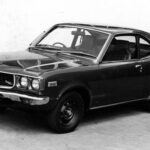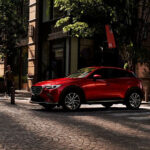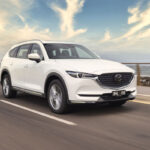 The ‘3’ has been a Mazda mainstay for several years. With the arrival of the third generation in Australia, it’s easy to see why. An even dozen variants tap in to technology usually found in vehicles at the luxury end of the premium market to offer generous specification at sharp prices.
The ‘3’ has been a Mazda mainstay for several years. With the arrival of the third generation in Australia, it’s easy to see why. An even dozen variants tap in to technology usually found in vehicles at the luxury end of the premium market to offer generous specification at sharp prices.
Offered in sedan and hatchback versions, the new Mazda3 comes with a choice of two engines: the 2.0- or 2.5-litre SkyActiv petrol engine, mated with either SkyActiv six-speed manual or six-speed automatic transmission.
Some familiar names turn up among the six grades available – Neo, Maxx,Touring, SP25 and SP25 GT. The Astina moniker, from way back, also makes a return to the fold.

Prices start at $20,490, plus on-road costs, for the 2.0-litre Mazda3 Neo manual and rise to $38,190 for the 2.5-litre SP25 Astina automatic, putting the Mazda3 at the heart of the compact market.
We spent a fair bit of time in a Mazda3 SP25 2.5 six-speed manual hatch listed at $25,890, which is below the launch price of the superseded model. The test car was fitted with a Mazda Safety Pack for an extra $1500, making the total coast $27,490 as tested.

STYLING
Mazda says it was out to create pleasing first impressions, designers calling on the company’s Kodo, Soul of Motion, design language previously used in the CX-5 compact SUV and Mazda6.
There’s no doubt the new ‘3 has a striking street presence, especially in its hatchback format, with its steeply raked profile.
In line with the latest front-end styling, the deep radiator grille is set low; the sleekness of the headlamps is strengthened by separating them from the turn signals, which are positioned above the foglamps.
The 18-inch alloy wheels of the SP25, 16-inch steel and alloys are used on the cheaper models, are designed to present a feeling of road-going agility with stability – or so we are told.
Inside the cabin there’s no ignoring the premium quality of materials used. The centre console, for example, is finished in piano black, contrasting with the metallic look of satin chrome trim. A long horizontal strip across the instrument panel visually extends the width and impression of open space.
INFOTAINMENT
The technology on offer takes the Mazda3 to new levels of occupant convenience and connectivity. With so much information at hand, Mazda’s Human Machine Interface was upgraded to help drivers better maintain proper posture while concentrating on the road.
Obviously even the best infotainment system is less safe than a car without any built-in distractions, but we feel the Mazda designers have come up with the best system we’ve used to date.
Mazda’s MZD Connect, works in conjunction with a smartphone to receive radio and play music from CDs and mobile audio players, while also giving access to internet radio such as Aha, Pandora and Stitcher.
The system can read email and short messages aloud while the vehicle is in motion using text-to-voice technology. Via smartphone, it can read aloud the latest Twitter tweets and Facebook news feed entries, and post audio messages using the Shout function.
Access to much of this is via Command control, a knob and switches situated on the centre console within easy reach of the driver connected to 7-inch a full-colour screen atop the dashboard. It is a direct pinch from those found in some luxury European cars costing much more than the Mazda3.
ENGINES
The test car was fitted with Mazda’s SkyActiv-G 2.5-litre petrol engine mated with a six-speed manual transmission, which the maker claims gives fuel consumption of 6.5 litres per 100 kilometres on the combined urban / highway cycle.
Fuel consumption during test turned out to be 5.2 litres per 100 km on the motorway, but up to 10 L/100 km on the daily city commute.
Efficiencies are won by weight savings in the engine, body and suspension, plus Mazda’s i-stop engine start / stop system which shuts down the motor when the car is stationery, for example at traffic lights.
SAFETY
As well as a full suite of active and passive safety systems such as anti-skid braking, stability control and airbags all round, the test vehicle was fitted with an optional Safety Pack for $1500, which includes a rear-view mirror with auto dimming function.
With this pack the driver has the added advantage of Blind Spot Monitoring and Smart City Brake Support, which automatically applies the brakes, helping prevent or soften impact with the vehicle ahead when travelling at slower speeds.
Then there’s Rear Cross Traffic Alert, which warns of vehicles about to cross behind the car when reversing.
DRIVING
Jinba Ittai is Mazda’s philosophy of making the driver and machine as one and goes a long way to achieving success. Keyless entry greets the driver before he or she settles into comfortable and supportive seats, which help to absorb some of the harshness of stiff suspension that’s aggravated by big-diameter wheels.
Handling is very good, ride on uneven surfaces not so smooth.
The six-speed manual transmission, with its short, crisp shift pattern, serves up sharp, responsive driving dynamics. Steering is positive and provides ample feedback to the driver.
Efficient brakes bring the vehicle to a smooth stop and Hill Launch Assist comes to the aid of the driver when setting off on steep inclines.
In the back, seatbacks of the front seats are hollowed to provide more knee room and floor mounts are positioned wide apart to give rear-seat occupants more space for their feet.
SUMMING UP
Brushing aside the tweeness of Kodo and Jinba Ittai, the new Mazda3 is a pleasant, practical, well-priced vehicle outfitted with features and quality materials way beyond its station. Despite the hype, don’t expect a sports car driving experience.
AT A GLANCE
MODEL
Mazda3 SP25 2.5-litre six-speed manual hatch: $25,890 ($27,490 as tested)
Note: This price does not include government or dealer delivery charges. Contact your local Mazda dealer for drive away prices.
FEATURES
18-inch alloy wheels with 215/45R18 tyres
Fog-lamps (front)
Rear spoiler (sedan)
Advanced keyless entry
Air-conditioning (dual-zone climate control)
Headlamps auto on/off function
Wipers (front) 2-speed with rain-sensing function
Safety Pack option ($1500) includes:
Rear-view mirror with auto dimming function
Blind Spot Monitoring (BSM)
Rear Cross Traffic Alert (RCTA)
Smart City Brake Support (SCBS)
SPECIFICATIONS (Mazda 3 SP25 2.5 petrol engine)
Capacity: 2488 cc
Configuration: 2.5 litre in-line 4-cylinder, 16-valve DOHC S-VT petrol (SKYACTIV-G) with i-stop
Bore x Stroke: 89.0 mm x 100.0 mm
Compression Ratio: 13.0:1
Maximum Power: 213 kW @ 5700 rpm
Maximum Torque: 250 Nm @ 3250 rpm
DRIVELINE:
Transmission: Six-speed manual
DIMENSIONS, WEIGHT AND CAPACITIES:
Length: 4460 mm
Width: 1795 mm
Height: 1455 mm
Wheelbase: 2700 mm
Track: 1555 mm (front); 1560 mm (rear)
Ground clearance: 155 mm
Kerb weight: 1308 kg
Cargo capacity: 308 litres
Fuel Tank Capacity: 51 litres
Towing capacity: 1200 kg (braked); 600 kg (unbraked)
Towball download (max): 75 kg
Turning circle: 10.6 m
Coefficient of friction: Cd 0.28
SUSPENSION AND BRAKES:
Suspension: MacPherson strut (front); multilink (rear)
Brakes: 295 mm ventilated disc (front); 265 mm solid disc (rear)
Steering: Electronic power assist
Wheels: 18in x 7.0J alloy (temporary steel spare)
Tyres: 215/45 R18
PERFORMANCE
Acceleration 0 to 100 km/h: N/A
Top speed: N/A
FUEL CONSUMPTION:
Fuel type: Unleaded or E10 (91RON or higher)
Combined Cycle (ADR 81/01): 6.5 litres per 100 km. CO2 emissions 153 g / km
Emissions: Euro V
GREEN VEHICLE GUIDE RATINGS:
Greenhouse Rating: 7.5 / 10
Air Pollution Rating: 7.5 / 10
STANDARD WARRANTY:
Three years / unlimited kilometres











